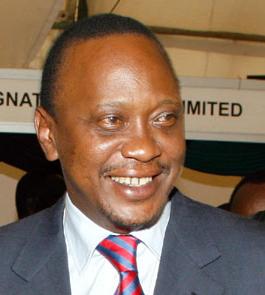With elections less than a month away many in Kenya are reading the tea leaves and making predictions as to who they think will win the March 4th presidential election. Unfortunately, many of these self-styled political analysts – including the most celebrated one Mutahi Ngunyi – are merely using the raw IEBC voter registration numbers and assumptions about ethnic bloc voting.
The reality, however, is that there will be differential voter turnout in the many ethnic zones regions of the country in a manner that will have a non-trivial impact on the outcome of the election. As I highlighted in a previous post, this will be a turnout election. Everyone knows who their voters are. The swing voters will be few. And the two major contenders don’t appear to have any intention or strategy to eat into each other’s perceived strongholds.
And so just as I did last time, I ran the numbers from the latest opinion poll from Ipsos Synovate with regional breakdowns to estimate the winner of the presidential election. This time round my turnout model also includes variables on income, voter registration, and whether a region has a top presidential contender or not.
So what do the numbers say?
Well, if the polls are right Uhuru Kenyatta still leads Raila Odinga by about 740,000 votes. I estimate that Mr. Kenyatta will get 48.87% of the votes cast to Mr. Odinga’s 41.72%, which means that a run-off is almost inevitable. I don’t expect Mr. Kenyatta to hit the 50% mark since my model is slightly biased in his favor (especially coming from the Rift Valley turnout figures from 2007 that I use as a basis of estimating turnout in 2013). Below I show the regional tallies according to my turnout model.
A few caveats to go with my estimates:
- Of course the polls could be all wrong, in which case none of what I say here matters.
- The result of the election will hinge on the turnout in the respective candidates’ strongholds. As it is my model estimates a turnout rate in Mr. Kenyatta’s strongholds at 77.33 to Mr. Odinga’s 66.68. Mr. Odinga can easily erase Mr. Kenyatta’s lead by matching his stronghold turnout rate and having a respectable showing in Western region (by eating into Mr. Mudavadi’s vote share) on March 4th.
- In the event of a run-off, all bets are off. Most likely the election will then centre on Mr. Kenyatta’s ethnicity (which is the same as that of the outgoing president) and his tribulations at the ICC thereby handing Mr. Odinga a lead straight off the gates.
| REGION | Uhuru Kenyatta | Raila Odinga |
| Coast | 64,064 | 410,012 |
| North Eastern | 103,978 | 115,531 |
| Eastern | 865,432 | 732,612 |
| Central | 1,623,483 | 113,266 |
| Rift Valley | 1,655,262 | 695,972 |
| Western | 58,040 | 444,974 |
| Nyanza | 282,626 | 1,299,053 |
| Nairobi | 406,099 | 507,624 |
| TOTAL | 5,058,984 | 4,319,044 |
For those interested in looking under the hood of Ipsos Synovate’s polls go here.
Hi Ken, im curious to find out how you came with the 282,626 figure for Jubilee in Nyanza and the Opinion poll by Synovate gives them 6%
LikeLike
Does your analysis factor in people who registered to vote from different places this time due to work? Instead of voting from usual home provinces during holiday season?
LikeLike
Pingback: Africa Blog Roundup: Kenya’s Elections, Nigeria’s Trains, DDR in South Sudan, and More | Sahel Blog
Reblogged this on Political Deficit and commented:
PoliticalDeficit will be reading up on the Iranian Presidential election too!
LikeLike
Pingback: Roundup: Kenya’s Presidential Debate | Sahel Blog
Pingback: Kenyan candidates trade barbs in first ever presidential debate | Hillbilly News
Pingback: The State of the 2013 Presidential Race in Kenya « Opalo's weblog
Pingback: Kenyan candidates trade barbs in first ever presidential debate | 2012 presidential
Interesting ….. so many ideas out there, i guess we will have to wait and see come march . Let their be peace.
LikeLike
Meant to say let there be peace….
LikeLike
Based on the referendum of 2010 voter turn out and having awarded Jubilee strongholds – kalenjinland and kikuyu dominated areas; an average of 80.3 voter turn out,and Jubilee leaning areas average of 67.2% Uhuru will end up with 5, 083, 482 at most.
I awarded Cordland of Nyanza 82.3%, voter turn out, Kisii,kamba and coast 60% and all other cordlineaning areas like turkana 52%, RAO will end up with 4,620,421.
It means from my model, Jubilee will get 48.5%, while cord will take 45%.
But if cord matches voter turn out to Jubilee, then they will push to 5.25M and win round one.
LikeLike
Does this mean that we are going to round 2? It is obvious that CORD is aware of voter turn out issue and will therefore ensure that their voters are out in large numbers. If this happens, then Raila wins round one…
LikeLike
Pingback: Uhuru Kenyatta Elected President of Kenya « Opalo's weblog
Pingback: Forecasting Politics Is Still Hard to Do (Well) | Dart-Throwing Chimp
Pingback: Kenyan pollsters eat humble pie « Opalo's weblog
Pingback: Top posts of 2013 « An Africanist Perspective
Pingback: By the Numbers: A Look at the 2017 Presidential Election in Kenya « An Africanist Perspective